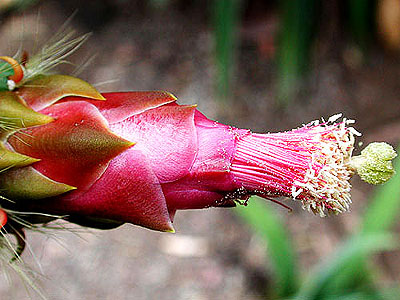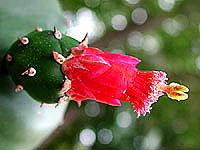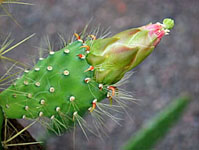 |
QUICK SEARCH
MO PROJECTS:
Africa
Asia/Pacific
Mesoamerica
North America
South America
General Taxonomy
Photo Essays
Training in Latin
America
MO RESEARCH:
Wm. L. Brown Center
Bryology
GIS
Graduate Studies
Research Experiences
for Undergraduates
Imaging Lab
Library
MBG Press
Publications
Climate Change
Catalog Fossil Plants
MO DATABASES:
W³MOST
Image Index
Rare Books
Angiosperm
Phylogeny
Res Botanica
All Databases
INFORMATION:
What's New?
People at MO
Visitor's Guide
Herbarium
Jobs & Fellowships
Symposium
Research Links
Site Map
Search
|
Draft Treatments | Guidelines | Checklist | Citing | Editors The Cutting EdgeVolume VIII, Number 2, April 2001News and Notes | Recent Treatments | Leaps and Bounds | Germane Literature | Season's Pick SEASON'S PICK: Opuntia lutea  Opuntia lutea, mature flower (Photo: B. Hammel)
The flowering of many species of Cactaceae marks the ending of the dry season in Costa Rica. Among those in bloom now or seen flowering recently are: Epiphyllum cartagense (F. A. C. Weber) Britton & Rose, Melocactus curvispinus Pfeiff., Peniocereus hirschtianus (K. Schum.) D. R. Hunt, Selenicereus wercklei (F. A. C. Weber) Britton & Rose, and our featured species for this issue: Opuntia lutea (Rose) D. R. Hunt. We have been waiting for this moment. Sterile or fruiting specimens--U. Chavarrķa 827, INB--of a (here) rare and then unknown species had been haunting us for years. Serendipitously, recent transfer of a Nopalea species to Opuntia led us to Nicaraguan material that matched ours nicely. Having planted cuttings here at INBioParque's Bosque Seco habitat, we watched anxiously the fl. bud that formed this March; the assumption being that if our plant turned out to have red, tubular flowers, the preliminary id. would be confirmed. The opening flowers are actually transparent green with just a hint of red, but as they mature, voila! This erect, tree or shrublike species is known from Guatemala, Honduras, Nicaragua, and now for sure, from Costa Rica. In CR it is known only from the limestone bluffs at Parque Nacional Palo Verde. Our one other native species of Opuntia, O. guatemalensis Britton & Rose, is a sprawling plant with open yellow flowers, much larger, usually white spines, and without the numerous fine yellow spine-hairs of O. lutea. The commonly cultivated O. cochenillifera (L.) Mill., also with red tubular flowers (but smaller) and no spines, is in bloom now, as well. |
© 1995-2025 Missouri Botanical Garden, All Rights Reserved
4344 Shaw Blvd.
St. Louis, MO 63110
(314) 577-5100
Technical Support

